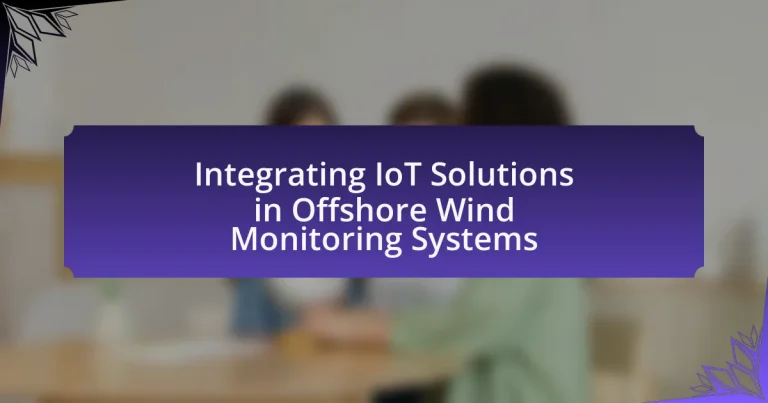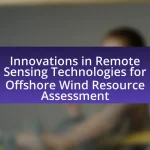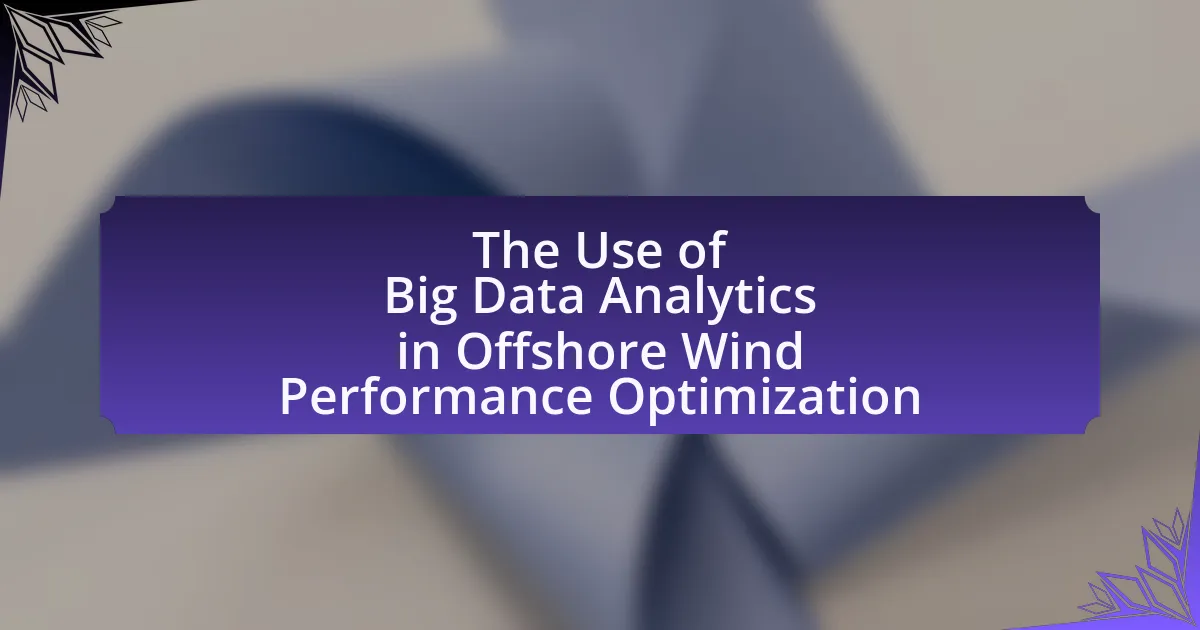Integrating IoT solutions in offshore wind monitoring systems involves the application of Internet of Things technologies to enhance the management and monitoring of wind farms in marine environments. This article outlines how IoT technologies, including sensors, data analytics, and communication networks, improve operational efficiency, reduce maintenance costs, and facilitate real-time monitoring. Key challenges such as harsh environmental conditions and data transmission issues are addressed, along with strategies for effective implementation and best practices. The article also explores future trends, including advancements in data analytics and artificial intelligence, which are expected to further optimize offshore wind monitoring systems.
What are IoT Solutions in Offshore Wind Monitoring Systems?
IoT solutions in offshore wind monitoring systems refer to the integration of Internet of Things technologies to enhance the monitoring and management of wind farms located in marine environments. These solutions typically involve the use of sensors, data analytics, and communication networks to collect real-time data on wind conditions, turbine performance, and environmental factors. For instance, sensors can monitor vibration, temperature, and wind speed, while data analytics can process this information to predict maintenance needs and optimize energy production. The implementation of IoT solutions has been shown to improve operational efficiency and reduce downtime, as evidenced by studies indicating that predictive maintenance can decrease maintenance costs by up to 30%.
How do IoT Solutions enhance Offshore Wind Monitoring?
IoT solutions enhance offshore wind monitoring by providing real-time data collection and analysis, which improves operational efficiency and safety. These solutions utilize sensors and connected devices to monitor various parameters such as wind speed, turbine performance, and environmental conditions. For instance, a study by the National Renewable Energy Laboratory found that integrating IoT technologies can reduce maintenance costs by up to 30% through predictive analytics, allowing for timely interventions before failures occur. Additionally, IoT systems facilitate remote monitoring, enabling operators to manage wind farms from anywhere, thus optimizing resource allocation and response times during adverse weather conditions.
What technologies are involved in IoT Solutions for wind monitoring?
IoT solutions for wind monitoring involve several key technologies, including sensors, communication protocols, cloud computing, and data analytics. Sensors are deployed to measure wind speed, direction, temperature, and humidity, providing real-time data essential for monitoring wind conditions. Communication protocols, such as MQTT and CoAP, facilitate the transmission of data from sensors to cloud platforms. Cloud computing enables the storage and processing of large volumes of data, allowing for scalable analysis and accessibility. Data analytics tools are then utilized to interpret the collected data, providing insights for optimizing wind energy production and maintenance. These technologies collectively enhance the efficiency and reliability of offshore wind monitoring systems.
How do sensors and data analytics contribute to monitoring systems?
Sensors and data analytics significantly enhance monitoring systems by providing real-time data collection and analysis capabilities. Sensors deployed in offshore wind monitoring systems capture critical environmental and operational parameters, such as wind speed, temperature, and equipment performance. This data is then processed through data analytics tools, which identify patterns, predict failures, and optimize performance. For instance, a study by the National Renewable Energy Laboratory found that predictive analytics can reduce maintenance costs by up to 30% by enabling proactive interventions based on sensor data. Thus, the integration of sensors and data analytics leads to improved efficiency, reliability, and safety in monitoring systems.
What challenges do Offshore Wind Monitoring Systems face?
Offshore Wind Monitoring Systems face several challenges, including harsh environmental conditions, data transmission issues, and high operational costs. The extreme weather, such as strong winds and saltwater corrosion, can damage equipment and affect data accuracy. Additionally, the remote locations of offshore wind farms complicate reliable data transmission to onshore facilities, often leading to data loss or delays. Furthermore, the installation and maintenance of monitoring systems are expensive due to the specialized equipment and skilled labor required, which can hinder the overall efficiency and scalability of offshore wind projects.
How can IoT Solutions address these challenges?
IoT solutions can address challenges in offshore wind monitoring systems by providing real-time data collection and analysis. These solutions utilize sensors and connected devices to monitor environmental conditions, equipment performance, and operational efficiency continuously. For instance, IoT-enabled sensors can detect changes in wind speed, temperature, and vibration, allowing for proactive maintenance and reducing downtime. According to a report by the International Renewable Energy Agency, implementing IoT technologies can enhance operational efficiency by up to 20%, demonstrating their effectiveness in addressing monitoring challenges in offshore wind systems.
What are the limitations of current monitoring systems without IoT?
Current monitoring systems without IoT face significant limitations, primarily in data accessibility and real-time analysis. Traditional systems often rely on manual data collection and periodic reporting, which leads to delays in decision-making and a lack of timely insights. For instance, without IoT integration, data from offshore wind turbines may only be collected weekly or monthly, hindering the ability to respond to operational issues promptly. Additionally, these systems typically lack the capability for remote monitoring, making it difficult to manage assets spread over vast geographical areas efficiently. The absence of automated alerts and predictive analytics further restricts the ability to foresee maintenance needs, potentially resulting in increased downtime and higher operational costs.
Why is integrating IoT Solutions crucial for Offshore Wind Monitoring?
Integrating IoT solutions is crucial for offshore wind monitoring because it enhances real-time data collection and analysis, leading to improved operational efficiency and safety. IoT devices, such as sensors and drones, enable continuous monitoring of wind turbine performance, environmental conditions, and structural integrity. This integration allows for predictive maintenance, reducing downtime and maintenance costs, as evidenced by a study from the National Renewable Energy Laboratory, which found that predictive maintenance can lower operational costs by up to 30%. Additionally, IoT solutions facilitate remote monitoring, enabling operators to respond swiftly to issues, thereby increasing the reliability and longevity of offshore wind assets.
What benefits do IoT Solutions provide in this context?
IoT solutions provide enhanced real-time monitoring and data collection in offshore wind monitoring systems. These solutions enable continuous tracking of turbine performance, environmental conditions, and operational efficiency, leading to improved decision-making and maintenance strategies. For instance, IoT sensors can detect anomalies in turbine operations, allowing for predictive maintenance that reduces downtime and operational costs. Additionally, the integration of IoT facilitates remote access to data, which enhances safety and reduces the need for on-site inspections. This capability is supported by studies indicating that IoT implementations can lead to a 20-30% reduction in maintenance costs and a significant increase in energy production efficiency.
How do IoT Solutions improve data accuracy and reliability?
IoT solutions improve data accuracy and reliability by enabling real-time data collection and analysis through interconnected devices. These devices, equipped with sensors, continuously monitor environmental conditions and operational parameters, ensuring that data is captured consistently and without human error. For instance, a study by the International Renewable Energy Agency (IRENA) highlights that IoT-enabled sensors in offshore wind farms can reduce data discrepancies by up to 30% compared to traditional monitoring methods. This enhanced accuracy is further supported by advanced analytics that filter out noise and anomalies, leading to more reliable insights for decision-making in offshore wind monitoring systems.
What role does real-time monitoring play in operational efficiency?
Real-time monitoring significantly enhances operational efficiency by providing immediate insights into system performance and potential issues. This capability allows organizations to quickly identify and address inefficiencies, reducing downtime and maintenance costs. For instance, in offshore wind monitoring systems, real-time data from IoT sensors enables operators to optimize energy production by adjusting turbine settings based on current wind conditions. Studies have shown that implementing real-time monitoring can lead to a 10-20% increase in operational efficiency by minimizing response times to equipment failures and improving resource allocation.
How do IoT Solutions impact maintenance and operational costs?
IoT solutions significantly reduce maintenance and operational costs by enabling predictive maintenance and real-time monitoring. By utilizing sensors and data analytics, these solutions allow for the early detection of equipment issues, which can prevent costly breakdowns and extend the lifespan of assets. For instance, a study by McKinsey & Company found that predictive maintenance can reduce maintenance costs by 10-40% and increase equipment uptime by 5-10%. This data demonstrates that the integration of IoT in offshore wind monitoring systems not only enhances operational efficiency but also leads to substantial cost savings.
What cost-saving measures can be implemented through IoT?
Cost-saving measures that can be implemented through IoT include predictive maintenance, real-time monitoring, and optimized resource management. Predictive maintenance leverages IoT sensors to monitor equipment health, allowing for timely repairs that prevent costly breakdowns; studies show that predictive maintenance can reduce maintenance costs by 10-40%. Real-time monitoring of offshore wind systems enables immediate detection of issues, minimizing downtime and associated losses; for instance, companies have reported up to 20% savings in operational costs through enhanced monitoring. Optimized resource management, facilitated by IoT data analytics, leads to more efficient energy production and reduced waste, with some organizations achieving up to 15% reductions in energy costs.
How does predictive maintenance enhance system longevity?
Predictive maintenance enhances system longevity by enabling timely interventions based on data-driven insights. This approach utilizes real-time monitoring and analytics to predict equipment failures before they occur, allowing for maintenance to be performed only when necessary. Research indicates that predictive maintenance can reduce unplanned downtime by up to 50%, significantly extending the operational life of systems. By addressing potential issues proactively, predictive maintenance minimizes wear and tear on components, thereby improving overall reliability and performance in offshore wind monitoring systems.
What are the best practices for integrating IoT Solutions in Offshore Wind Monitoring Systems?
The best practices for integrating IoT solutions in offshore wind monitoring systems include ensuring robust data security, utilizing standardized communication protocols, and implementing real-time data analytics. Robust data security is essential to protect sensitive information from cyber threats, as offshore wind farms are often remote and vulnerable. Standardized communication protocols, such as MQTT or CoAP, facilitate interoperability among various devices and systems, enhancing data exchange efficiency. Real-time data analytics enables operators to monitor performance and detect anomalies promptly, improving maintenance strategies and operational efficiency. These practices are supported by industry standards and case studies demonstrating enhanced reliability and performance in offshore wind operations.
How can organizations effectively implement IoT Solutions?
Organizations can effectively implement IoT solutions by establishing a clear strategy that includes defining objectives, selecting appropriate technologies, and ensuring robust data management. A well-defined strategy allows organizations to align IoT initiatives with business goals, such as improving operational efficiency or enhancing monitoring capabilities. Selecting the right technologies, such as sensors and communication protocols, is crucial for effective data collection and transmission. Additionally, implementing strong data management practices ensures that the data collected is accurate, secure, and actionable. According to a report by McKinsey, organizations that adopt a structured approach to IoT implementation can achieve up to 30% improvement in operational efficiency, demonstrating the effectiveness of a strategic framework.
What steps should be taken for successful integration?
Successful integration of IoT solutions in offshore wind monitoring systems requires a structured approach that includes defining clear objectives, selecting appropriate technologies, ensuring robust data management, and fostering collaboration among stakeholders.
First, defining clear objectives involves identifying specific goals for the integration, such as improving data accuracy or enhancing operational efficiency. Next, selecting appropriate technologies entails evaluating various IoT devices and platforms that can effectively monitor wind conditions and system performance.
Robust data management is crucial; this includes establishing protocols for data collection, storage, and analysis to ensure that the information gathered is reliable and actionable. Finally, fostering collaboration among stakeholders, including engineers, data scientists, and operational teams, is essential for aligning efforts and ensuring that the integration meets the intended objectives.
These steps are supported by industry practices that emphasize the importance of a systematic approach to technology integration, as seen in successful case studies within the renewable energy sector.
How can training and support be structured for personnel?
Training and support for personnel can be structured through a combination of hands-on workshops, online courses, and ongoing mentorship programs. These methods ensure that personnel gain practical experience with IoT technologies while also having access to theoretical knowledge. For instance, hands-on workshops can facilitate direct interaction with monitoring systems, allowing personnel to troubleshoot and understand real-time data analysis. Online courses can provide foundational knowledge about IoT principles and applications in offshore wind monitoring. Additionally, mentorship programs can pair less experienced personnel with seasoned experts, fostering a culture of continuous learning and support. This structured approach enhances skill development and ensures personnel are well-equipped to manage and optimize IoT solutions effectively.
What common pitfalls should be avoided during integration?
Common pitfalls to avoid during integration of IoT solutions in offshore wind monitoring systems include inadequate planning, lack of interoperability, and insufficient data security measures. Inadequate planning can lead to misalignment of project goals and technical requirements, resulting in delays and increased costs. Lack of interoperability among different IoT devices and platforms can hinder data exchange and system functionality, as evidenced by studies showing that 70% of IoT projects fail due to compatibility issues. Insufficient data security measures can expose systems to cyber threats, with reports indicating that 60% of IoT devices have vulnerabilities that can be exploited. Addressing these pitfalls is crucial for successful integration and optimal performance of offshore wind monitoring systems.
How can organizations ensure data security and privacy?
Organizations can ensure data security and privacy by implementing robust encryption protocols, access controls, and regular security audits. Encryption protects sensitive data both in transit and at rest, making it unreadable to unauthorized users. Access controls limit data access to authorized personnel only, reducing the risk of data breaches. Regular security audits help identify vulnerabilities and ensure compliance with data protection regulations, such as GDPR, which mandates strict data handling and privacy measures. These practices collectively enhance the security framework necessary for safeguarding data in environments like offshore wind monitoring systems, where IoT solutions are increasingly utilized.
What strategies can mitigate integration risks?
To mitigate integration risks in offshore wind monitoring systems, employing a structured approach that includes thorough planning, stakeholder engagement, and robust testing is essential. Thorough planning involves defining clear objectives and requirements for the IoT solutions, ensuring alignment with existing systems and processes. Engaging stakeholders throughout the integration process fosters collaboration and addresses potential concerns early on. Additionally, implementing a phased testing strategy allows for the identification and resolution of issues in a controlled environment before full deployment. These strategies are supported by industry best practices, which emphasize the importance of risk assessment and management in technology integration projects.
What future trends can be expected in IoT Solutions for Offshore Wind Monitoring?
Future trends in IoT solutions for offshore wind monitoring include enhanced data analytics, increased use of artificial intelligence, and improved sensor technology. Enhanced data analytics will enable real-time monitoring and predictive maintenance, allowing operators to optimize performance and reduce downtime. The integration of artificial intelligence will facilitate advanced pattern recognition and anomaly detection, leading to more efficient operations. Additionally, improved sensor technology will provide more accurate and reliable data collection, which is crucial for assessing environmental impacts and turbine performance. These trends are supported by the growing demand for renewable energy and advancements in IoT infrastructure, which are driving innovation in offshore wind monitoring systems.
How will advancements in technology shape monitoring systems?
Advancements in technology will significantly enhance monitoring systems by enabling real-time data collection, improved analytics, and increased automation. For instance, the integration of Internet of Things (IoT) devices allows for continuous monitoring of offshore wind turbines, providing instant feedback on performance and environmental conditions. This capability is supported by advancements in sensor technology, which can capture a wide range of data, including vibration, temperature, and wind speed, leading to more accurate assessments of system health. Furthermore, machine learning algorithms can analyze this data to predict maintenance needs, reducing downtime and operational costs. The combination of these technologies results in more efficient and reliable monitoring systems, ultimately optimizing the performance of offshore wind energy operations.
What role will artificial intelligence play in future integrations?
Artificial intelligence will play a crucial role in future integrations by enhancing data analysis and decision-making processes in offshore wind monitoring systems. AI algorithms can process vast amounts of data generated by IoT devices, enabling real-time monitoring and predictive maintenance, which improves operational efficiency. For instance, AI can analyze sensor data to predict equipment failures, reducing downtime and maintenance costs. Additionally, AI-driven analytics can optimize energy production by adjusting operational parameters based on environmental conditions, thereby maximizing output. This integration of AI into offshore wind monitoring systems is supported by advancements in machine learning and data analytics, which have demonstrated significant improvements in predictive capabilities and operational insights.
What practical tips can enhance the integration of IoT Solutions?
To enhance the integration of IoT solutions in offshore wind monitoring systems, organizations should prioritize interoperability, ensuring that devices from different manufacturers can communicate effectively. This can be achieved by adopting standardized communication protocols such as MQTT or CoAP, which facilitate seamless data exchange. Additionally, implementing robust data security measures is crucial, as IoT devices are often vulnerable to cyber threats; using encryption and secure authentication methods can mitigate these risks. Furthermore, investing in scalable cloud infrastructure allows for efficient data storage and processing, accommodating the growing volume of data generated by IoT devices. Lastly, continuous monitoring and maintenance of the IoT ecosystem are essential to ensure optimal performance and address any emerging issues promptly.




